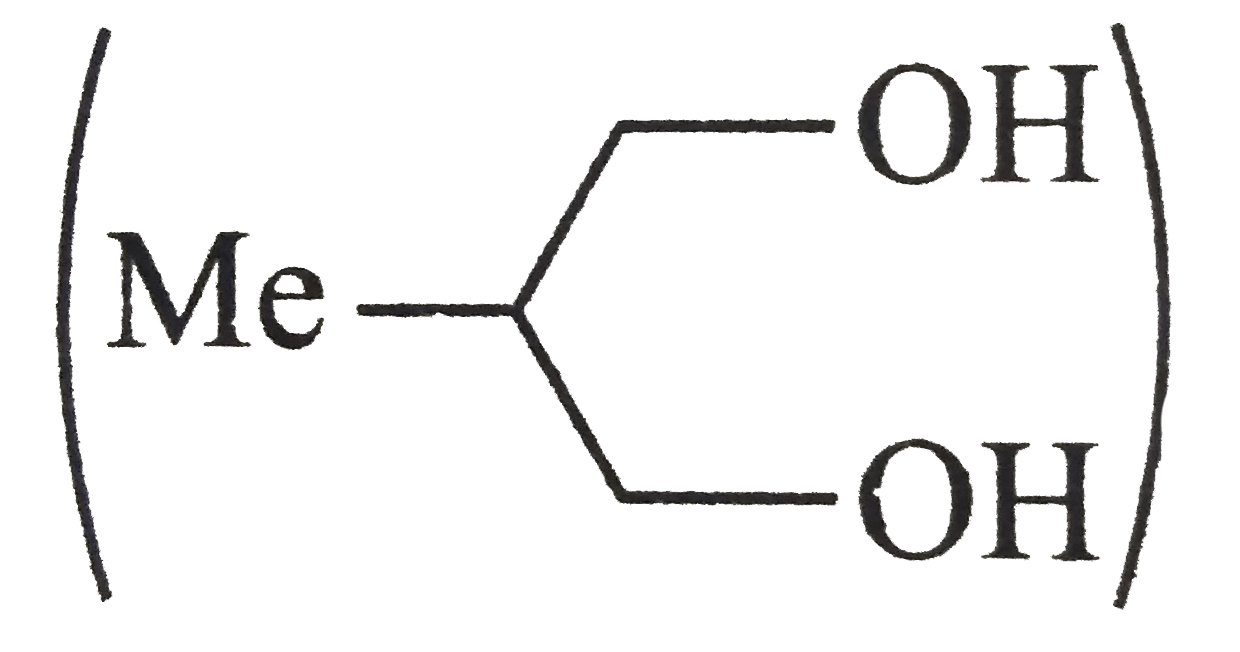Four isomeric optically active compounds NaHCO3−−−−−→CO2(g)(A,B,C,D)(C4H8O3)
Compound (A)LAH−−→(E) (Archiral compound)
Compound (B)KMnO4−−−−−→orCrO3 Inert to oxidation.
Compound (C)−−−−−−−−→NaOI/H3O⊕CHI3(Yellowppt.)+Compound(F).
Compound (D) is :




The correct Answer is:B
(b) (i) From the structures gives in the problem, (A) is (I). Since with LAH it would give achiral compound (E).

(ii) (B) id (IV), since ethers are inert to oxidation.
(iii) Iosoform test is shown by (II), so (C) is (II).
(iv)  .
.
Topper's Solved these Questions
- CARBOXYLIC ACIDS AND THEIR DERIVATIVESBOOK - CENGAGE CHEMISTRY ENGLISHCHAPTER - CARBOXYLIC ACIDS AND THEIR DERIVATIVESEXERCISE - Exercises (Multiple Correct)
34 Videos
- CARBOXYLIC ACIDS AND THEIR DERIVATIVESBOOK - CENGAGE CHEMISTRY ENGLISHCHAPTER - CARBOXYLIC ACIDS AND THEIR DERIVATIVESEXERCISE - Exercises (Singlecorrect)
64 Videos
- CARBOXYLIC ACIDS AND THEIR DERIVATIVESBOOK - CENGAGE CHEMISTRY ENGLISHCHAPTER - CARBOXYLIC ACIDS AND THEIR DERIVATIVESEXERCISE - Exercises (Subjective)
19 Videos
- BIOMOLECULESBOOK - CENGAGE CHEMISTRY ENGLISHCHAPTER - BIOMOLECULESEXERCISE - Exercises Archives (Analytical And Descriptive)
8 Videos
- CHEMICAL KINETICSBOOK - CENGAGE CHEMISTRY ENGLISHCHAPTER - CHEMICAL KINETICSEXERCISE - Archives Subjective
23 Videos
Similar Questions
What transition in the hydrogen spectrum would have the same wavelength as the Balmer transition, n = 4 to n = 2 of He+ spectrum?
View SolutionThe decreasing order of ester formation with benzoic acid in presence of H⊕ is :
(I)
View SolutionAcetyl chloride is hydrolysed rapidly by water, whereas benzoyl chloride is not.
View SolutionAlanine, the amino acid the respective structure at pH = 2 and pH = 10 will be
View SolutionRate of a reaction A+B→ Product, is given as a function of different initial concentration of A and B.
∣∣ ∣ ∣ ∣ ∣ ∣∣[A](molL−1)(B)(molL−1)Initial rate(molL−1−1min)0.010.010.0050.020.010.0100.010.020.005∣∣ ∣ ∣ ∣ ∣ ∣∣
Determine the order of the reaction with respect to A and with respect to B. What is the half life of A in the reaction ?
View SolutionColemanite+Na2CO3Fused−−→(A)+(B)+CO2
(A)Solution+CO2→(B)+Na2CO3
(B)+concHCl→NaCl+(C)Acid
(C)Acid+H2O→(D)Acid
(D)Strong heating−−−−−−−−→(E)
(E)+CuSO4Heated−−−→inflame(F)Blue-coloured compound.
Compound (D) is.
View SolutionFour isomeric optically active compounds NaHCO3−−−−−→CO2(g)(A,B,C,D)(C4H8O3)
Compound (A)LAH−−→(E) (Archiral compound)
Compound (B)KMnO4−−−−−→orCrO3 Inert to oxidation.
Compound (C)−−−−−−−−→NaOI/H3O⊕CHI3(Yellowppt.)+Compound(F).
Compound (A) is :
View SolutionFour isomeric optically active compounds overset (NaHCO_3) rarr CO_2 (g) (A, B , C, D) (C_4 H_8 O_3) Compound (A) overset (LAH) rarr ( E) (Archiral compound) Compound (B) overset (KMnO_4) underset (or CrO_3) rarr Inert to oxidation. Compound ( C) underset (NaOI//H_3 O^(oplus)) rarr CHI_3 (Yellow ppt.) + Compound (F) . Compound (B) is :
View SolutionFour isomeric optically active compounds overset (NaHCO_3) rarr CO_2 (g) (A, B , C, D) (C_4 H_8 O_3) Compound (A) overset (LAH) rarr ( E) (Archiral compound) Compound (B) overset (KMnO_4) underset (or CrO_3) rarr Inert to oxidation. Compound ( C) underset (NaOI//H_3 O^(oplus)) rarr CHI_3 (Yellow ppt.) + Compound (F) . Compound ( C) is :
View SolutionFour isomeric optically active compounds NaHCO3−−−−−→CO2(g)(A,B,C,D)(C4H8O3)
Compound (A)LAH−−→(E) (Archiral compound)
Compound (B)KMnO4−−−−−→orCrO3 Inert to oxidation.
Compound (C)−−−−−−−−→NaOI/H3O⊕CHI3(Yellowppt.)+Compound(F).
Compound (D) is :
View SolutionFour isomeric optically active compounds NaHCO3−−−−−→CO2(g)(A,B,C,D)(C4H8O3)
Compound (A)LAH−−→(E) (Archiral compound)
Compound (B)KMnO4−−−−−→orCrO3 Inert to oxidation.
Compound (C)−−−−−−−−→NaOI/H3O⊕CHI3(Yellowppt.)+Compound(F).
Compound (F) is :
View SolutionColemanite + G (compound) rarr A + B + C
CΔ−−→D+E(gas)Baryta water−−−−−−−→
milkyE+H2O−−−−→milkyness disappears
B+E(gas)→A+G,AΔ−−→F+B
F+CuO→Blue bead
Compound 'A' is :
View SolutionThe compound (C) in the given sequence of reaction is , C_6H_5OHoverset(NaOH)rarr(A)overset(CO_2)rarr(B)overset(HCl)rarr(C)
View Solution(C(A)H3COOHPCl5−−→[B]),CH3COOHNaOH−−−→[C]),[B]+[C]→[D]):}
यौगिक [B], [C] तथा [D] है |
View SolutionIdentify organic compounds [A, B, C]: CH_3CHO underset((ii)H_3O^oplus)overset((i)CH_3MgBr)rarr A underset(H_2SO_4)overset(K_2Cr_2O_7)rarr B overset(SeO_2)rarr C
View Solutionজৈব যৌগগুলি শনাক্ত করো [A,B,C]: (HCOO)_2Ca overset(শুষ্ক পাতন)rarr A overset(CH_3CH_2MgI)rarr B overset(H_3O^oplus)rarr C
View Solution
